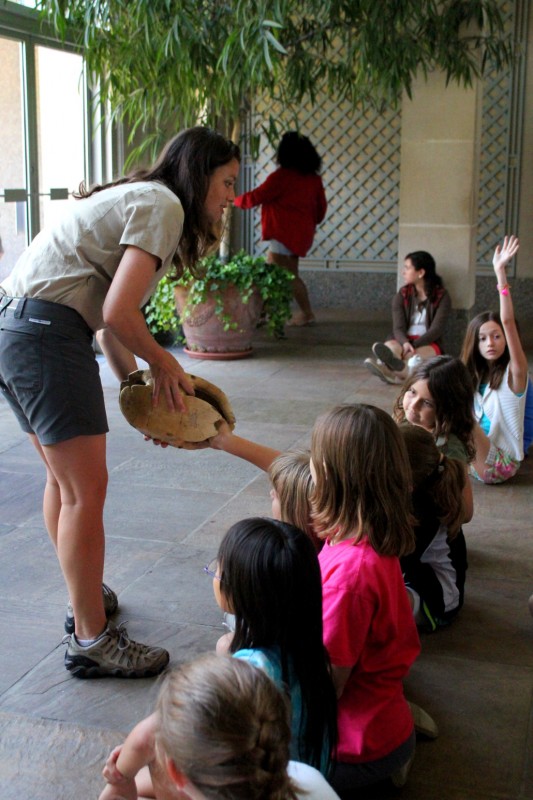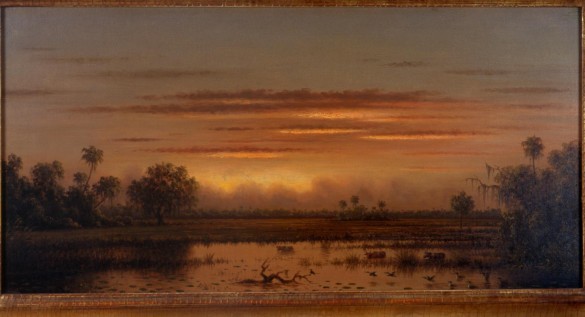It is July, about half way between school terms, and it is week five of Camp Cummer. As usual, the summer at the Cummer has its rains and heat, its humidity and sweating brows. Art fills the studios, curiosity echoes in the galleries and lunchtime brings out a “roaring” play in the Gardens, as the campers tap into new found energy. Except for Wednesdays; at lunch on Wednesdays the campers, instead of exercising their legs, flex their minds as they are treated to a special program presented by an educator from the St. Johns Riverkeeper.
 Since campers may attend two separate camp weeks during the summer, Riverkeeper presents two alternating programs. One week the program discusses the St. Johns River, its attributes and its value, and during the other week we learn about the Timucuan who lived along the St Johns; their dependency on and care of the River, and how their River lifestyles compare to ours.
Since campers may attend two separate camp weeks during the summer, Riverkeeper presents two alternating programs. One week the program discusses the St. Johns River, its attributes and its value, and during the other week we learn about the Timucuan who lived along the St Johns; their dependency on and care of the River, and how their River lifestyles compare to ours.
 We learn that the St. Johns is the longest river in Florida traveling 310 miles from its headwaters south of Melbourne, northward, where it empties into the Atlantic Ocean near Mayport. Only dropping 30 feet from its start to its end (about one inch per mile), the river is slow moving and becomes salty (brackish) as it nears the incoming tides near its mouth. The water is also brown, sometimes called “black water”, and this color is not because of pollution but because of naturally occurring chemicals called tannins. The riverkeeper makes the origin of this chemical quite apparent as she compares the changing colors of clear water in glass jars; one jar with a tea bag and the other with leaves from our Cummer live oak. Low and behold, the same tannins that are in tea leaves and make tea brown in color are in live oak leaves and, yes, make the St. Johns River brown in color. (Appropriate oohs and aahs are allowed right about now.) The tannins not only color the water but also make it slightly acidic and sweet tasting.
We learn that the St. Johns is the longest river in Florida traveling 310 miles from its headwaters south of Melbourne, northward, where it empties into the Atlantic Ocean near Mayport. Only dropping 30 feet from its start to its end (about one inch per mile), the river is slow moving and becomes salty (brackish) as it nears the incoming tides near its mouth. The water is also brown, sometimes called “black water”, and this color is not because of pollution but because of naturally occurring chemicals called tannins. The riverkeeper makes the origin of this chemical quite apparent as she compares the changing colors of clear water in glass jars; one jar with a tea bag and the other with leaves from our Cummer live oak. Low and behold, the same tannins that are in tea leaves and make tea brown in color are in live oak leaves and, yes, make the St. Johns River brown in color. (Appropriate oohs and aahs are allowed right about now.) The tannins not only color the water but also make it slightly acidic and sweet tasting.
Tannins, naturally occurring plant polyphenol compounds that precipitate proteins, are not only in our tea and in our River, they are common to us in other places. They give an astringent taste to wines or unripe fruits, they are in our red beans (in our red beans and rice), in the cinnamon of our cinnamon toast and in our dark chocolate. Tannins are also responsible for the colors seen in flowers and in autumn leaves. And, yes, tannins are used in “tanning”, the waterproofing and preserving of animal hides into leather.

Martin Johnson Heade (American, 1819 – 1904), The St. Johns River, c.1890s, oil on canvas, 13 x 26 in., Purchased with funds from Membership Contributions, AP.1966.29.1.
The River has always been important; in art as exemplified by the oil on canvas, The St. Johns River by Martin Johnson Heade, and presently hanging in the La Florida exhibit; in the City of Jacksonville as shown by the population and industry that settled here; and to Florida as a whole. There are many ecosystems that depend on this water system which include many hundreds of species of birds, mammals (including us), reptiles, amphibians, fish, mollusks, and plants. The riverkeeper effectively demonstrates interdependency, by stringing us all together. Some of us are plants; some are birds or other animals. We are plant eaters, meat eaters, and everything eaters and our relationship to each other shown by each of us holding onto a single rope. A rope strung between food source and consumer, habitat and inhabitant. A tug any place along the line is felt by several; if one drops their hold, many others also lose contact. With this we all experience that we are all connected to the River and have responsibility for actions that affect it.
During this summer, the riverkeeper has shared many things with us, only some mentioned above. There is also a manatee silhouette, which 25 campers can stand within its outline; stories about the Timucuan along the River, including the creation, and use of middens; and much more. With all this new found knowledge about the St. Johns River, the campers are encouraged to be aware of their actions, to make thoughtful decisions, and remain informed and engaged, so they might reduce their impact upon the River and play a part to aid in its protection and restoration.
Camp Cummer thanks the St. Johns Riverkeeper for their contribution to this year’s summer program and we look forward to many more.
For more information on Camp Cummer: https://www.cummer.org/camp-cummer
For more information on St. Johns Riverkeeper: https://www.stjohnsriverkeeper.org/


